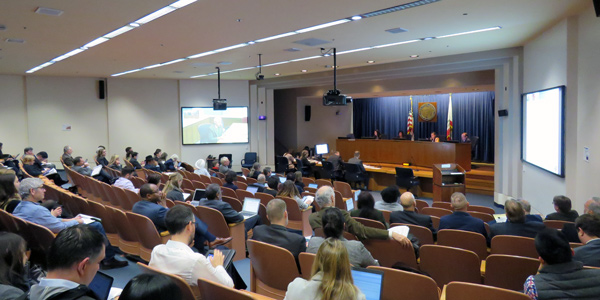By Jason Fordney
SAN FRANCISCO — California regulators last week issued several decisions that will affect the state’s energy resource mix and markets, including approving the retirement of the Diablo Canyon nuclear plant and replacing three reliability-must-run contracts for gas-fired generators with energy storage.
In its first meeting of 2018, the California Public Utilities Commission also approved exploring more uses for energy storage and pilot programs for new electric vehicle infrastructure. But staff delayed until Feb. 8 a vote on a proposal that would subject community choice aggregators (CCAs) to resource adequacy requirements, an idea that has drawn swift opposition from CCA supporters.
Fraction of Negotiated Cost Recovery
The CPUC unanimously approved the retirement of Pacific Gas and Electric’s 2,240-MW Diablo Canyon plant in San Luis Obispo County, the last remaining nuclear plant in the state. But the commission granted only a fraction of the $1.8 billion in cost recovery that was included in a joint proposal negotiated between PG&E and labor and environmental groups.
CPUC President Michael Picker said that with the decision, “We chart a new energy future by phasing out nuclear power here in California in 2024 and 2025.” Attending the meeting by teleconference, he called it “a very difficult and contentious case,” but “we agree the time has come.”
Diablo Canyon represents 6% of energy generated in California, but it is exacerbating overgeneration and curtailment of renewable resources. The plant is also aging and not needed for local reliability, Picker said. PG&E’s load is dropping with the growth of CCAs, direct access users (that buy directly from wholesale) and customer-based generation such as rooftop solar.
Picker said the order also directs PG&E to explore shutting the plant’s two units down earlier, in 2020 and 2022.
The CPUC rejected provisions in the joint proposal that would have paid for $1.3 billion in energy efficiency projects. An administrative law judge had proposed denying the efficiency cost recovery because the utility is already required to make that effort. (See PG&E Disputes ALJ’s Diablo Canyon Recommendation.)
The commission also rejected provisions in the joint proposal that allocated $85 million to mitigate the impact of the plant’s closure on the local community. Local officials say the plant is the hub of the local economy, but the CPUC said it would not authorize assistance without legislative direction.
The CPUC did approve recovery of $211 million to retain PG&E employees until the plant closes, $11 million for employee retraining of workers and $19 million for license renewal expenses already incurred. The commission said replacement capacity would be addressed in its integrated resource plan proceeding.
Parties to the joint proposal include PG&E, International Brotherhood of Electrical Workers Local 1245, Coalition of California Utility Employees, Friends of the Earth, Natural Resources Defense Council, Environment California, California Energy Efficiency Industry Council and Alliance for Nuclear Responsibility.
PG&E said it was “disappointed” the full proposal was not approved, but it noted the CPUC increased funding for employee retention above what was in the proposed decision.
“The joint proposal represents an array of interests from many parties who joined together to promote the best path forward for our state and PG&E’s customers,” the utility said in a news release. “Since the full proposal was not approved, in line with our agreement, PG&E will be meeting to confer with our labor, community and environmental group partners in the days ahead about the decision, our next steps and the path forward.”
Commissioners noted the significance of the plant and the new challenges involved with retiring a major energy resource. Commissioner Martha Guzman Aceves called it a “landmark decision” to get a safer source of energy that is also clean. Commissioner Clifford Rechtschaffen noted that the commission intends to ensure the replacement capacity does not increase greenhouse gas emissions.
Elizabeth Echols, director of California’s Office of Ratepayer Advocates (ORA), said, “PG&E customers benefit from this decision because it protects customers from paying $1.56 billion in unnecessary costs, while providing important funding for PG&E employee retention and retraining programs. Today’s decision is well-supported by the evidence ORA and other parties provided in this case.”
The two units at Diablo Canyon went online in 1985 and 1986.
RMR, Storage, EV Measures Passed

In its consent agenda, the CPUC passed a resolution to replace RMRs inked between CAISO and Calpine for the Metcalf, Yuba City and Feather River plants in PG&E’s service territory. The contracts have created tensions among ISO stakeholders and signal the state’s resource adequacy is not meeting reliability needs. The decision requires PG&E to hold solicitations to replace the RMRs with energy storage. (See CPUC Targets CAISO’s Calpine RMRs.)
Commissioner Carla Peterman also developed two decisions approved by the CPUC, including one adopting 11 rules governing multiple-use applications for energy storage. The decision creates a framework enabling energy storage companies to stack their offerings and provide more than one service to the wholesale market, distribution grid, transmission system and resource adequacy programs. The rule, developed in coordination with CAISO and other agencies, is supported by energy storage companies.
“This is the first time any commission has tried to do anything like this,” Peterman said.
Her other proposed decision supports new EV pilot projects, which she called “an important issue for the state of California.” It directs PG&E, Southern California Edison and San Diego Gas & Electric to invest $41 million in pilot projects for school buses, delivery trucks, airport/seaport equipment, truck stops and commuter locations. Other projects include the installation of fast charging for urban locations and car dealerships, the commission said.
The full list of the CPUC’s approved, withdrawn and held decisions from the Jan. 11 meeting is available here.






